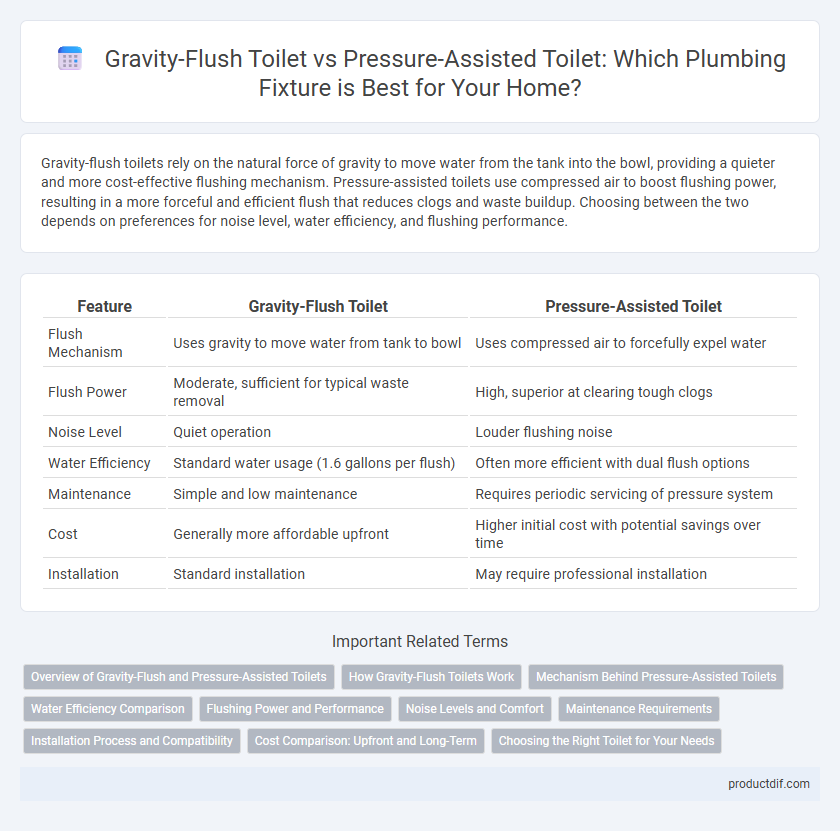Gravity-flush toilets rely on the natural force of gravity to move water from the tank into the bowl, providing a quieter and more cost-effective flushing mechanism. Pressure-assisted toilets use compressed air to boost flushing power, resulting in a more forceful and efficient flush that reduces clogs and waste buildup. Choosing between the two depends on preferences for noise level, water efficiency, and flushing performance.
Table of Comparison
| Feature | Gravity-Flush Toilet | Pressure-Assisted Toilet |
|---|---|---|
| Flush Mechanism | Uses gravity to move water from tank to bowl | Uses compressed air to forcefully expel water |
| Flush Power | Moderate, sufficient for typical waste removal | High, superior at clearing tough clogs |
| Noise Level | Quiet operation | Louder flushing noise |
| Water Efficiency | Standard water usage (1.6 gallons per flush) | Often more efficient with dual flush options |
| Maintenance | Simple and low maintenance | Requires periodic servicing of pressure system |
| Cost | Generally more affordable upfront | Higher initial cost with potential savings over time |
| Installation | Standard installation | May require professional installation |
Overview of Gravity-Flush and Pressure-Assisted Toilets
Gravity-flush toilets rely on the natural force of gravity to move water from the tank into the bowl, using a simple and quiet mechanism that is energy-efficient and cost-effective. Pressure-assisted toilets utilize compressed air within the tank to forcefully propel water, providing a more powerful flush that minimizes clogs and improves overall performance in high-demand settings. Both systems serve different needs, with gravity-flush toilets favored for residential use and pressure-assisted models preferred in commercial or heavy-use environments due to their enhanced flushing capabilities.
How Gravity-Flush Toilets Work
Gravity-flush toilets operate by using the force of gravity to move water from the tank into the bowl, creating a siphon that flushes waste efficiently. The tank fills with water, and when the flush lever is activated, a flapper valve lifts, allowing the water to rush down through the trapway. This gravity-driven mechanism relies on an optimal height difference between the tank and bowl to maintain sufficient water pressure and effective flushing performance.
Mechanism Behind Pressure-Assisted Toilets
Pressure-assisted toilets use compressed air to forcefully expel water into the bowl, creating a powerful flush that clears waste more efficiently than gravity-flush toilets. The mechanism involves a sealed inner tank where air is compressed during tank refilling, increasing water velocity and pressure in the flush cycle. This design reduces clogs and improves water usage, making pressure-assisted toilets ideal for high-traffic or commercial settings.
Water Efficiency Comparison
Gravity-flush toilets typically use 1.6 gallons per flush (GPF), making them moderately water-efficient, while some modern models reduce usage to 1.28 GPF or less. Pressure-assisted toilets utilize a pressurized tank to deliver a more forceful flush, often requiring slightly more water per flush, around 1.6 to 2 gallons, but achieving superior bowl cleanliness with fewer flushes. WaterSense-certified gravity-flush models generally outperform pressure-assisted toilets in water savings due to lower per-flush volume and optimal flushing performance.
Flushing Power and Performance
Gravity-flush toilets rely on the natural force of gravity to move water from the tank into the bowl, providing a quiet and efficient flush suitable for standard household use. Pressure-assisted toilets use compressed air to forcefully propel water into the bowl, resulting in a more powerful and faster flush that effectively handles heavier waste and reduces clogs. The enhanced flushing performance of pressure-assisted models makes them ideal for commercial settings or homes requiring higher flushing power, while gravity-flush toilets offer reliable performance with lower noise and maintenance.
Noise Levels and Comfort
Gravity-flush toilets produce minimal noise due to their reliance on natural water flow, making them ideal for quiet bathroom environments. Pressure-assisted toilets operate with higher force and often generate louder flushing sounds, which may be disruptive in noise-sensitive settings. Comfort in gravity-flush toilets is enhanced by smoother, gentler flushing, while pressure-assisted models provide robust flushing power but can feel harsher during use.
Maintenance Requirements
Gravity-flush toilets require less frequent maintenance due to their simpler design with fewer moving parts, reducing the risk of mechanical failures. Pressure-assisted toilets demand more regular inspections and maintenance to ensure the pressure tank and seals remain intact, preventing leaks and performance issues. Choosing a gravity-flush toilet can lower long-term maintenance costs, while pressure-assisted models may incur higher expenses due to their complex components.
Installation Process and Compatibility
Gravity-flush toilets feature a straightforward installation process compatible with most standard plumbing systems, requiring no specialized fittings or high-pressure lines. Pressure-assisted toilets demand a more complex installation, including reinforced water supply lines and often professional assistance to handle the internal pressure tank mechanism safely. Compatibility issues may arise with older homes where existing plumbing cannot support the higher water pressure needed for pressure-assisted models.
Cost Comparison: Upfront and Long-Term
Gravity-flush toilets typically have a lower upfront cost, ranging from $100 to $300, compared to pressure-assisted toilets, which often start around $200 and can exceed $500. Long-term maintenance costs for gravity-flush models tend to be lower due to simpler mechanisms and fewer parts prone to wear, whereas pressure-assisted toilets may incur higher repair expenses related to their pressurized systems. Energy efficiency remains comparable since both types use similar water amounts per flush, but pressure-assisted units can reduce water waste in commercial settings, potentially lowering utility bills over time.
Choosing the Right Toilet for Your Needs
Gravity-flush toilets operate quietly and use less water per flush, making them ideal for residential settings seeking efficiency and low maintenance. Pressure-assisted toilets deliver powerful flushes by using compressed air, effectively reducing clogs and suitable for high-traffic commercial spaces. Evaluating factors like water consumption, flush performance, and noise levels helps determine the best toilet type to meet specific plumbing needs.
gravity-flush toilet vs pressure-assisted toilet Infographic

 productdif.com
productdif.com